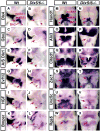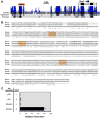Dlx genes pattern mammalian jaw primordium by regulating both lower jaw-specific and upper jaw-specific genetic programs
- PMID: 18697905
- PMCID: PMC4913551
- DOI: 10.1242/dev.019778
Dlx genes pattern mammalian jaw primordium by regulating both lower jaw-specific and upper jaw-specific genetic programs
Abstract
Dlx transcription factors are implicated in patterning the mammalian jaw, based on their nested expression patterns in the first branchial arch (primordium for jaw) and mutant phenotypes; inactivation of Dlx1 and Dlx2 (Dlx1/2-/-) causes defects in the upper jaw, whereas Dlx5/6(-/-) results in homeotic transformation of the lower jaw into upper jaw. Therefore, the 'Dlx codes' appear to regionalize the jaw primordium such that Dlx1/2 regulate upper jaw development, while Dlx5/6 confer the lower jaw fate. Towards identifying the genetic pathways downstream of Dlx5/6, we compared the gene expression profiles of the wild-type and Dlx5/6(-/-) mouse mandibular arch (prospective lower jaw). We identified 20 previously unrecognized Dlx5/6-downstream genes, of which 12 were downregulated and 8 upregulated in the mutant. We found a Dlx-regulated transcriptional enhancer in close proximity to Gbx2, one of the Dlx5/6-downstream genes, strongly suggesting that Gbx2 is a direct target of Dlx5/6. We also showed that Pou3f3 is normally expressed in the maxillary (prospective upper jaw) but not mandibular arch, is upregulated in the mandibular arch of Dlx5/6(-/-), and is essential for formation of some of the maxillary arch-derived skeleton. A comparative analysis of the morphological and molecular phenotypes of various Dlx single and double mutants revealed that Dlx1, 2, 5 and 6 act both partially redundantly and antagonistically to direct differential expression of downstream genes in each domain of the first branchial arch. We propose a new model for Dlx-mediated mammalian jaw patterning.
Figures








Similar articles
-
Reassessing the Dlx code: the genetic regulation of branchial arch skeletal pattern and development.J Anat. 2005 Nov;207(5):501-61. doi: 10.1111/j.1469-7580.2005.00487.x. J Anat. 2005. PMID: 16313391 Free PMC article. Review.
-
Twist1 Acts Upstream of the Dlx5-Hand2 Pathway to Pattern the Mammalian Jaw.J Dent Res. 2025 Mar;104(3):310-319. doi: 10.1177/00220345241291527. Epub 2024 Dec 20. J Dent Res. 2025. PMID: 39707586
-
Role of Dlx genes in craniofacial morphogenesis: Dlx2 influences skeletal patterning by inducing ectomesenchymal aggregation in ovo.Evol Dev. 2010 Sep-Oct;12(5):459-73. doi: 10.1111/j.1525-142X.2010.00432.x. Evol Dev. 2010. PMID: 20883215
-
The insufficiency of Dlx5 for ventral patterning in post-migratory neural crest cells reveals a loss of plasticity in early jaw-forming tissue.Biochem Biophys Res Commun. 2022 Nov 26;631:110-114. doi: 10.1016/j.bbrc.2022.09.069. Epub 2022 Sep 23. Biochem Biophys Res Commun. 2022. PMID: 36183551
-
DLX gene expression in the developing chick pharyngeal arches and relationship to endothelin signaling and avian jaw patterning.Dev Dyn. 2024 Feb;253(2):255-271. doi: 10.1002/dvdy.653. Epub 2023 Sep 14. Dev Dyn. 2024. PMID: 37706631 Review.
Cited by
-
In vitro induction of patterned branchial arch-like aggregate from human pluripotent stem cells.Nat Commun. 2024 Feb 14;15(1):1351. doi: 10.1038/s41467-024-45285-0. Nat Commun. 2024. PMID: 38355589 Free PMC article.
-
Transcriptional regulation of enhancers active in protodomains of the developing cerebral cortex.Neuron. 2014 Jun 4;82(5):989-1003. doi: 10.1016/j.neuron.2014.04.014. Epub 2014 May 8. Neuron. 2014. PMID: 24814534 Free PMC article.
-
Mandible and Tongue Development.Curr Top Dev Biol. 2015;115:31-58. doi: 10.1016/bs.ctdb.2015.07.023. Epub 2015 Oct 1. Curr Top Dev Biol. 2015. PMID: 26589920 Free PMC article. Review.
-
The Gq/11 family of Gα subunits is necessary and sufficient for lower jaw development.Development. 2025 Apr 15;152(8):dev204396. doi: 10.1242/dev.204396. Epub 2025 Apr 17. Development. 2025. PMID: 40171762 Free PMC article.
-
Conserved and unique transcriptional features of pharyngeal arches in the skate (Leucoraja erinacea) and evolution of the jaw.Mol Biol Evol. 2021 Sep 27;38(10):4187-4204. doi: 10.1093/molbev/msab123. Mol Biol Evol. 2021. PMID: 33905525 Free PMC article.
References
-
- Abdollahi A, Roberts D, Godwin AK, Schultz DC, Sonoda G, Testa JR, Hamilton TC. Identification of a zinc-finger gene at 6q25: a chromosomal region implicated in development of many solid tumors. Oncogene. 1997;14:1973–1979. - PubMed
-
- Acampora D, Merlo GR, Paleari L, Zerega B, Pia Postiglione M, Mantero S, Bober E, Barbieri O, Simeone A, Levi G. Craniofacial, vestibular and bone defects in mice lacking the Distal-less related gene Dlx5. Development. 1999;126:3795–3809. - PubMed
-
- Ackerman SL, Kozak LP, Przyborski SA, Rund LA, Boyer BB, Knowles BB. The mouse rostral cerebellar malformation gene encodes an UNC-5-like protein. Nature. 1997;386:838–842. - PubMed
Publication types
MeSH terms
Substances
Grants and funding
LinkOut - more resources
Full Text Sources
Other Literature Sources
Molecular Biology Databases

